I was about to spring for a clamp-on portage yoke from Oak Orchard, then got hold of an old Mad River yoke from a friend so I'm gonna give it a go and make my own. Anybody got any simple plans or ideas? Its gonna carry my Curtis Blue Gill.
-
Happy Birthday, Judge Joseph Wapner (1919-2017)! 📺🤼⚖️
You are using an out of date browser. It may not display this or other websites correctly.
You should upgrade or use an alternative browser.
You should upgrade or use an alternative browser.
DIY solo portage yoke ideas?
- Thread starter jish1969
- Start date
Sure. Easy-peasy assuming you're clamping to a fat wood gunwale.
 20150719_002 by Alan, on Flickr
20150719_002 by Alan, on Flickr
Lots of ways to do similar setups. This one is just a thick piece of wood cut to shape. I worried about it splitting in the corner so I glued up two pieces of 1x material instead. Make sure you align them so you're not gluing end grain. For my last one, which I don't have any handy pictures of, I did it a little differently and I think it's an easier, better, and stronger design. I'll try to get a pic of it later.
In the above photo there's a 1/4" carriage bolt running up from below. After screwing on the knob I put a nylon lock nut on top of the bolt to keep the knob from twiddling off on its own.
Alan
 20150719_002 by Alan, on Flickr
20150719_002 by Alan, on FlickrLots of ways to do similar setups. This one is just a thick piece of wood cut to shape. I worried about it splitting in the corner so I glued up two pieces of 1x material instead. Make sure you align them so you're not gluing end grain. For my last one, which I don't have any handy pictures of, I did it a little differently and I think it's an easier, better, and stronger design. I'll try to get a pic of it later.
In the above photo there's a 1/4" carriage bolt running up from below. After screwing on the knob I put a nylon lock nut on top of the bolt to keep the knob from twiddling off on its own.
Alan
Hopefully these pics will give you some ideas.
I've been working on a portage yoke/ backrest for sometime. It works, but seems heavy.
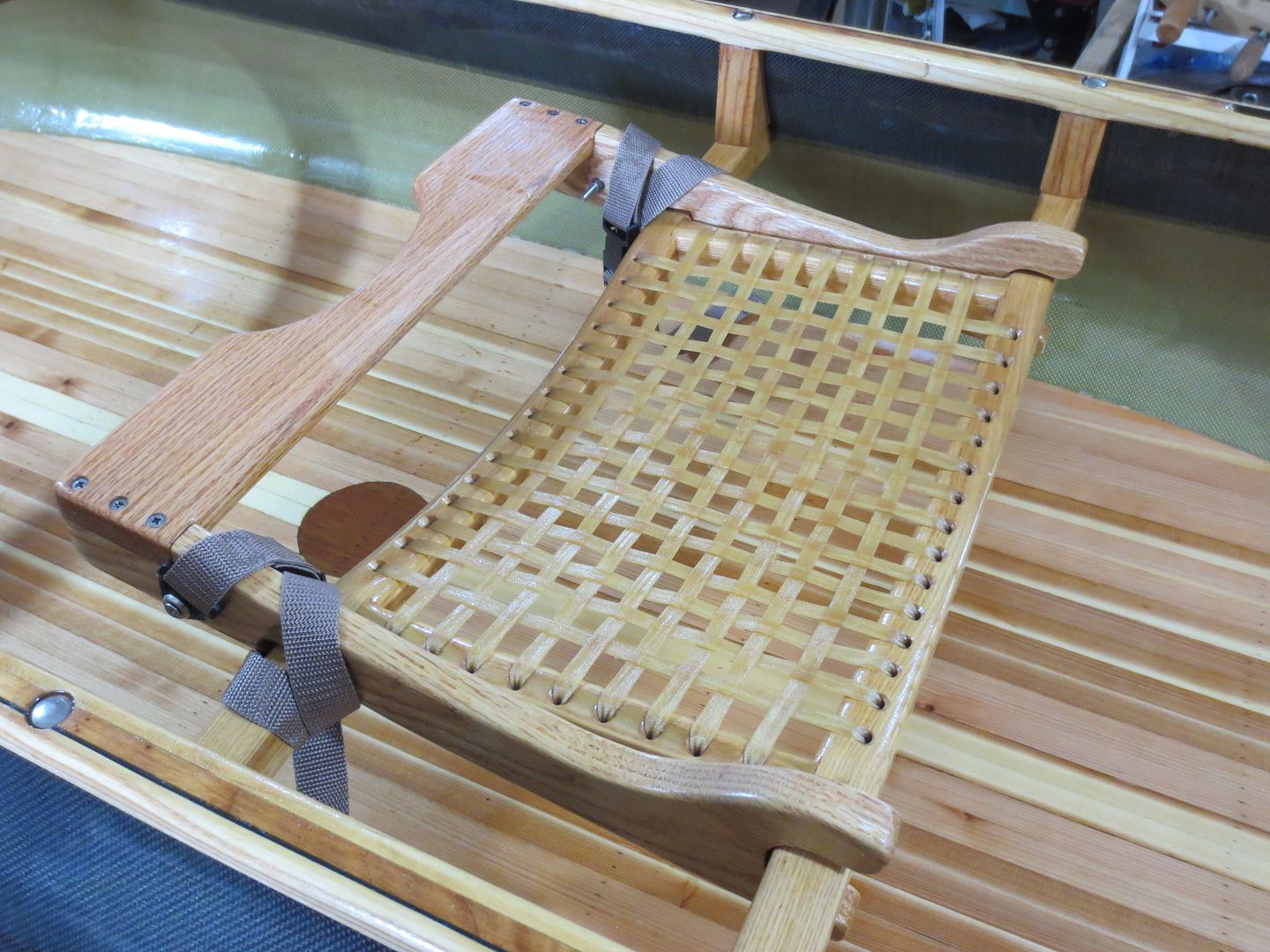
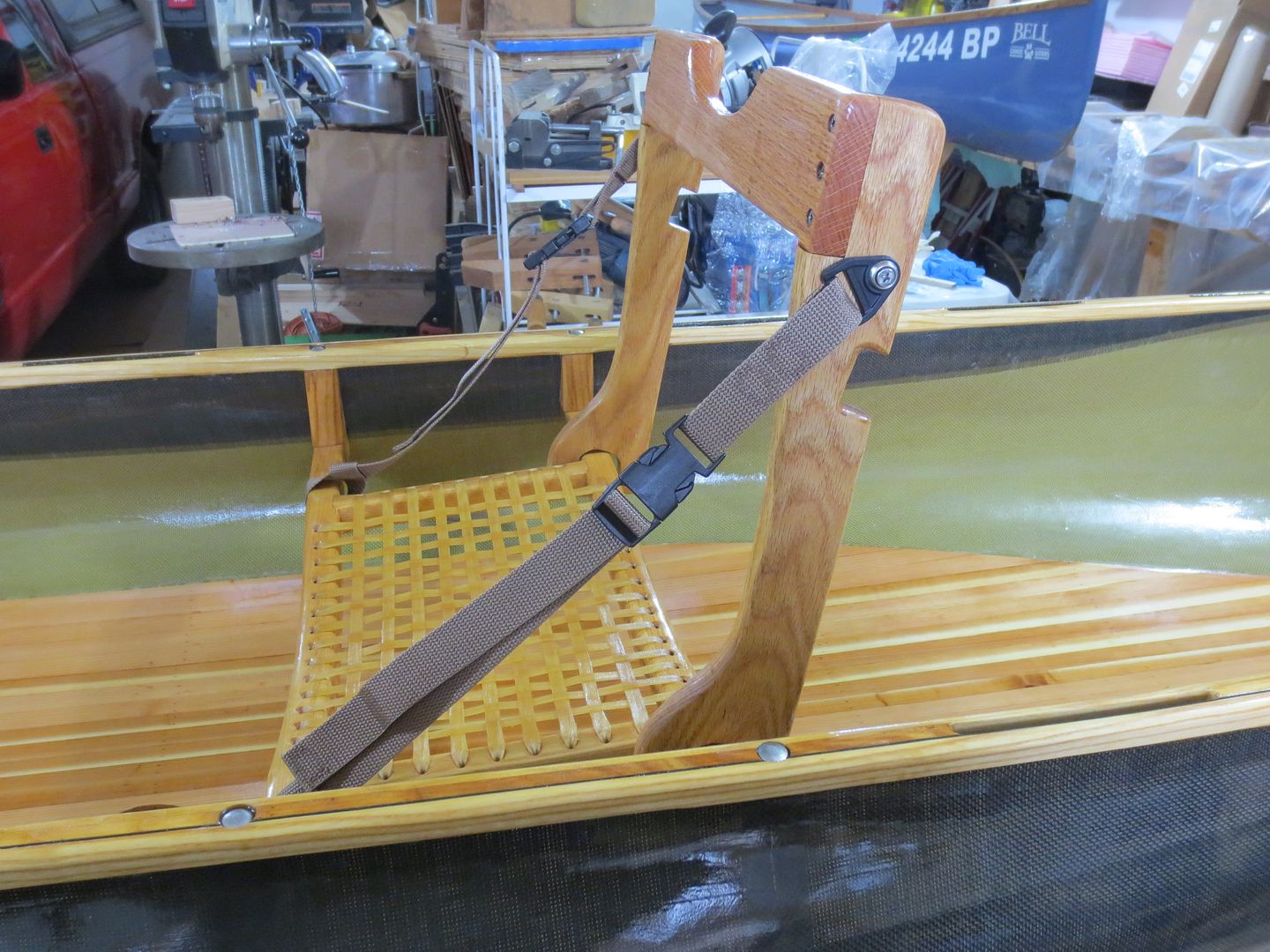
I have a few more. The above pics are of course without the pads installed.
Early proto type.
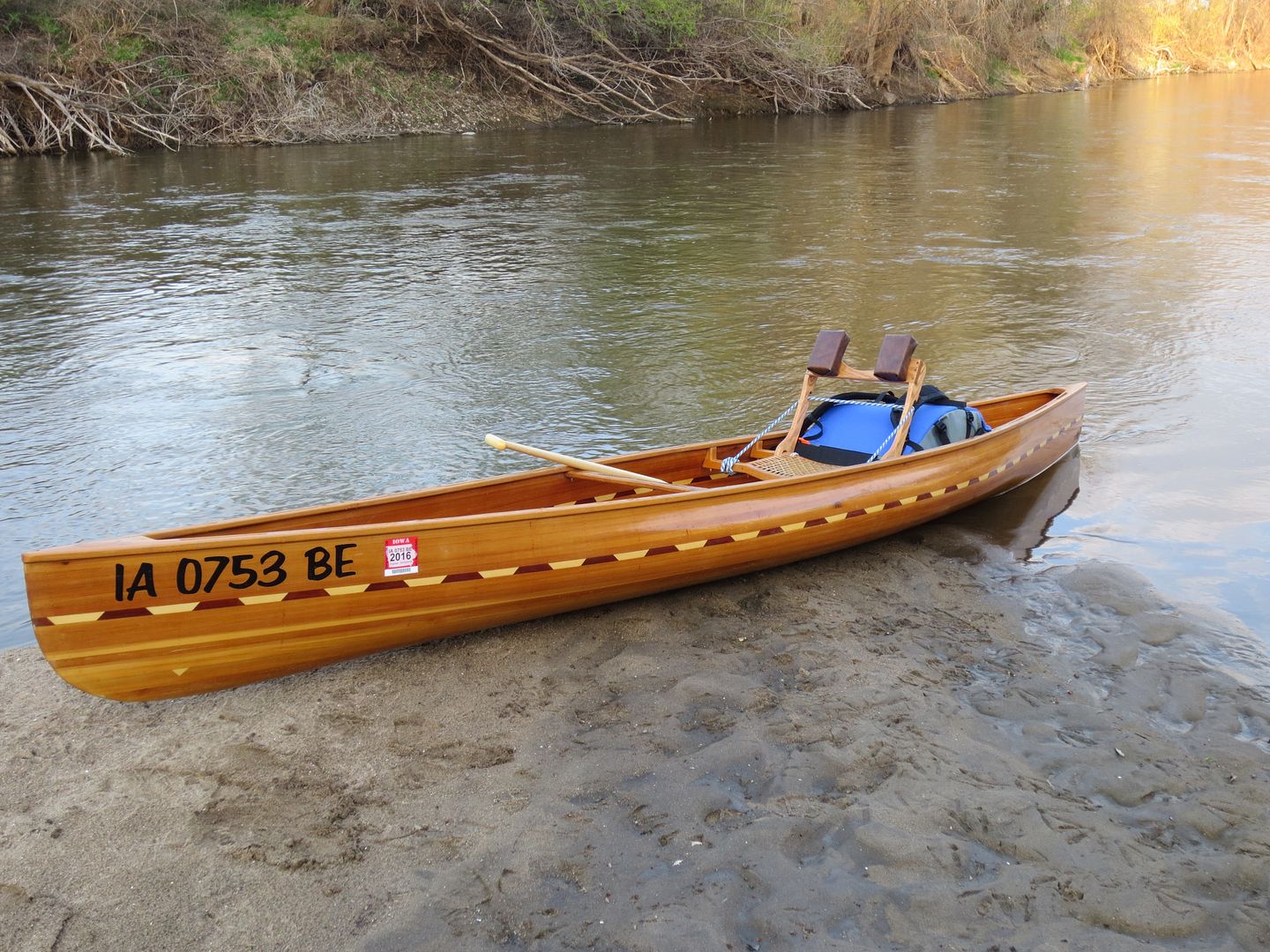
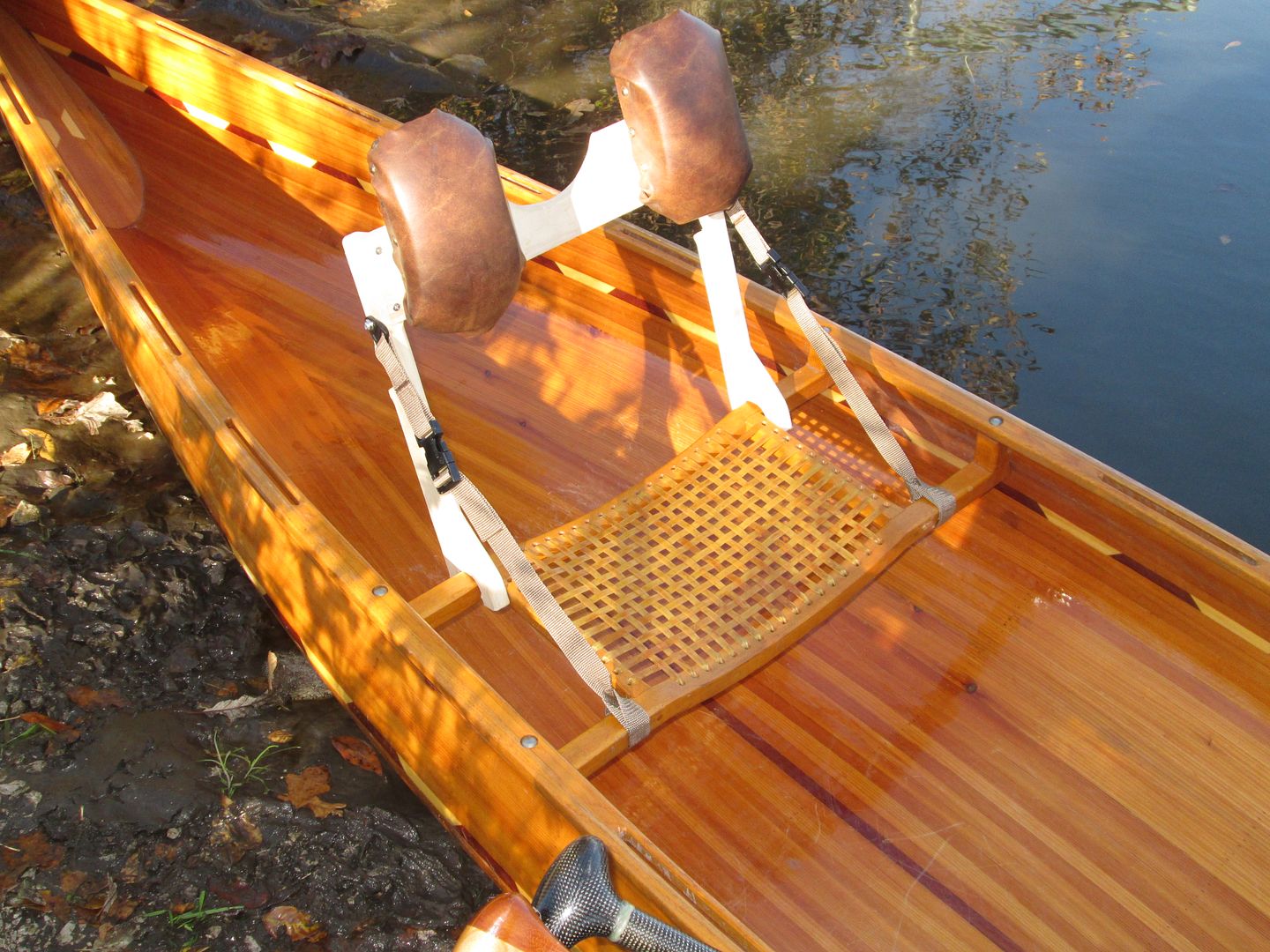
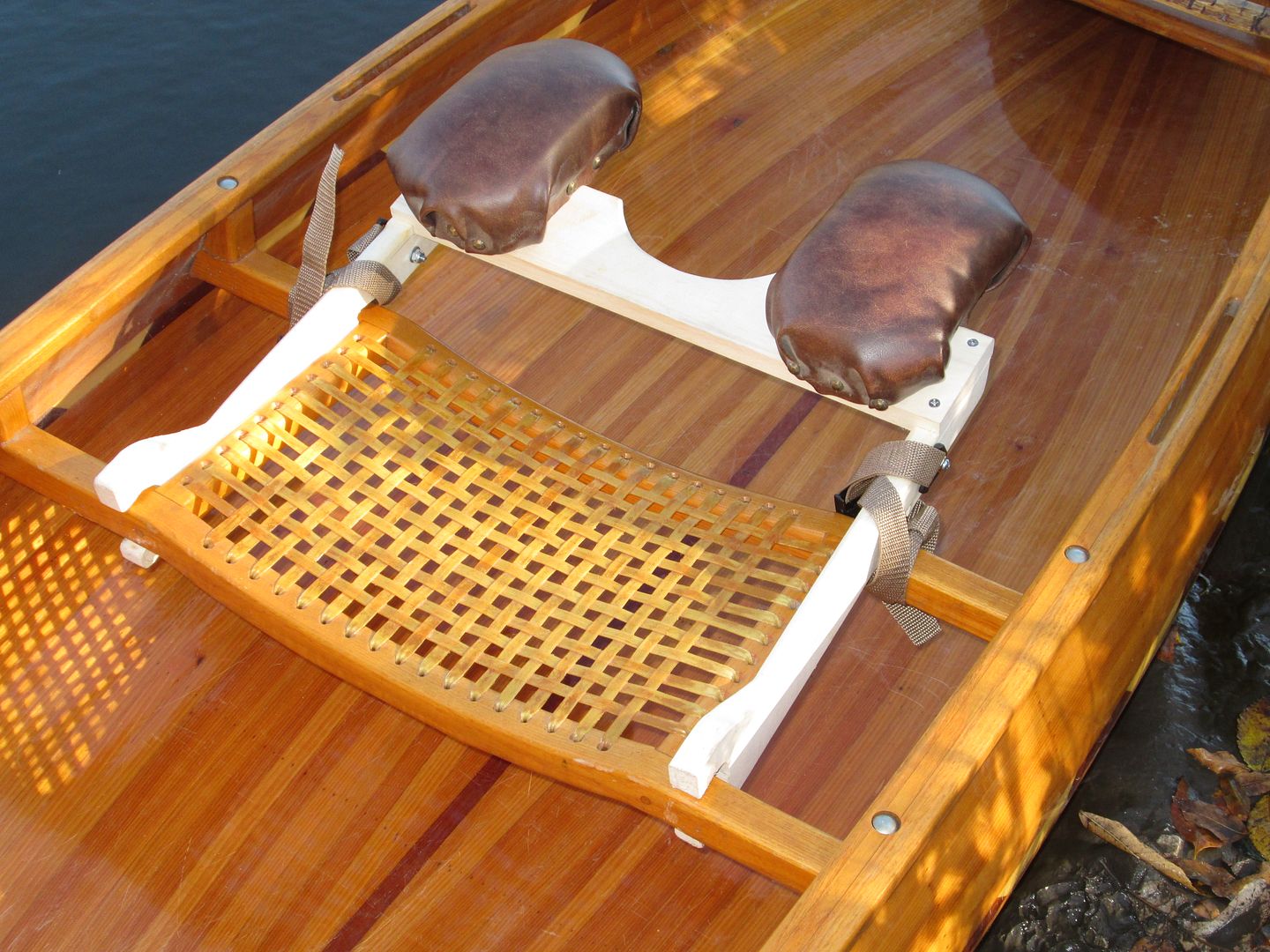
Jim
I've been working on a portage yoke/ backrest for sometime. It works, but seems heavy.


I have a few more. The above pics are of course without the pads installed.
Early proto type.



Jim
Last edited:
I built one like Jim Dodd's minus the backrest option after seeing a picture of one. I cut out a cardboard pattern and fine tuned it before cutting out the wood. It sure beats messing around with clamps.
I've never had the tools or skills to shape wood. So, when I had an extra Mad River portage yoke, I converted it into a clamp-on with L-shaped aluminum clamps for the gunwales along with carriage bolts and screw knobs, which I stole off a canoe motor mount I no longer used. The L-shapes had square holes to fit the carriage bolts and prevent turning. I'm sure these components are available from somewhere.
G
Guest
Guest
I was about to spring for a clamp-on portage yoke from Oak Orchard, then got hold of an old Mad River yoke from a friend so I'm gonna give it a go and make my own. Anybody got any simple plans or ideas? Its gonna carry my Curtis Blue Gill.
I have had, and still have, a variety of manufactured and DIY removable yokes. From sundry experiences I would contemplate a number of sometimes opposing design elements:
The easier the yoke is to install/remove, without having to fiddle with parts while working upside-down and backwards kneeling in the mud, the more you will like it
The more small parts and pieces it has to possibly drop, lose or misplace the less you will like it.
It really needs to be conveniently attached or secured to the canoe when not in use. The less it escapes from the canoe (or rattles around) the more you will like it.
Don’t forget to bring it, or you really won’t like it. That really sucked.
(YMMV, those were my sundry complaints)
For truck to water, or short easy carries with a lightweight boat I just use a strap yoke and know that it is always available in the canoe and strap-fastens in seconds.
This thing:
https://mohawk-canoes.myshopify.com/collections/flat-water-canoe-parts/products/webbing-yoke
Or DIY a better one using 2 inch webbing and two large strainless D-rings. Looks like this when not in use.
3 feet of rolled up 2 inch webbing under inwale restrained via double sides Velcro straps:
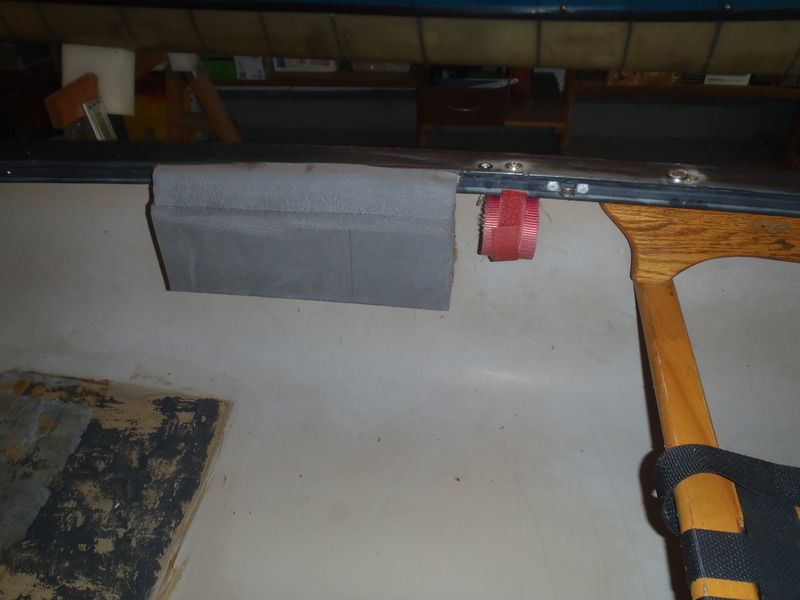
Two (there are two there) 2 inch stainless D-rings:
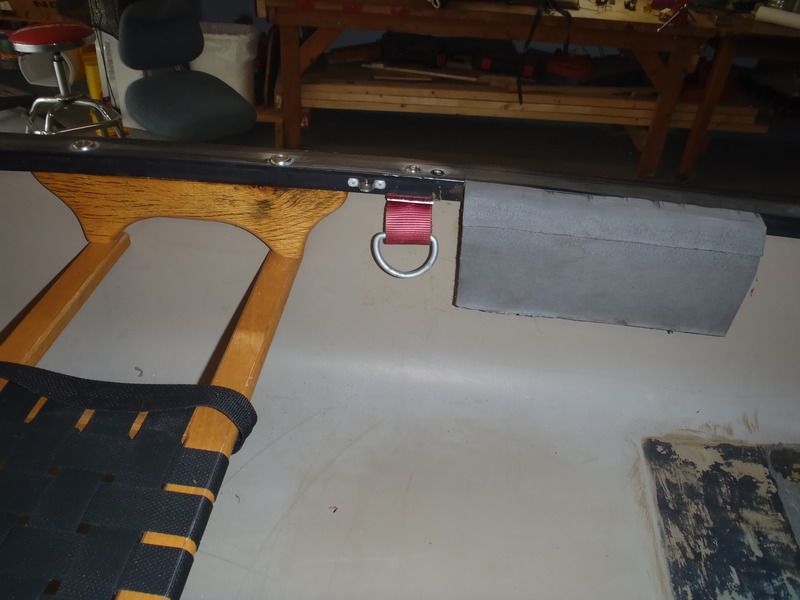
Those are shown on a 76 lb Royalex hull; I trust the D-rings more than side release buckles. A Bluegill was 44 lbs in glass, or 35 in kevlar. Hmmm. . . . .
For a long or hard carry I would want a real portage yoke, but that always-there, strapped or unstrapped in seconds webbing yoke is awfully convenient at times.
G
Guest
Guest
Mike, do the 2" D-rings ever make rattling together noise when the strap is not woven through? Would I be over thinking it by putting a velcro keeper on them as well?
Not that I have every noticed while paddling with the strap unfastened and rolled up, the D-rings dangle quietly straight down even in slop and bouncy waves.
When the canoe is on the truck racks the strap is connected between the D-rings since I’m using the webbing yoke to put the boat on and take it off. And the connected strap has never “hummed” on the roof racks of any vehicle.
For the DIY version it helps to melt a sealed 3/16 inch hole using a 20-penny nail heated with a torch, and use a stress-spreading washer under the webbing on both sides.
A little Velcro “keeper” for the D-rings is probably superfluous, but couldn’t hurt. See this handy stuff:
http://www.canoetripping.net/forums...p-velcro-bundling-strap-double-sided-velcro
One semi-critical hint for using a strap yoke; DO NOT pull it all the way taut, especially with nylon webbing (use poly). It will be a b*tch to get unfastened from woven between the two D-rings, especially if it has shrunk guitar-string tight between the inwales.
Don’t ask how I know that, just picture me frustrated and mumbling stupidstupidstupid under my breath. I was ready to use the rescue knife when I finally got some play in the straps.
(BTW, Stupidstupidstupid. Stop and think there dumdum. With shrunk tight nylon don’t reach for the knife; just saturate it with water and wait a minute, it’ll stretch.
I will use a clamp-on/screw-on/hinge-on yoke if need be, but I have that simple webbing yoke installed on almost every canoe. I really don’t want to leave a removable yoke installed with the canoe on the roof racks while travelling for potential jiggle parts loss concerns.
Plus I like the fact that the strap yoke is always there and easy to connect; I can’t forget to bring it, and don’t have to futz with wood yoke connections at both ends of a 30 yard carry.
Not that I have every noticed while paddling with the strap unfastened and rolled up, the D-rings dangle quietly straight down even in slop and bouncy waves.
When the canoe is on the truck racks the strap is connected between the D-rings since I’m using the webbing yoke to put the boat on and take it off. And the connected strap has never “hummed” on the roof racks of any vehicle.
For the DIY version it helps to melt a sealed 3/16 inch hole using a 20-penny nail heated with a torch, and use a stress-spreading washer under the webbing on both sides.
A little Velcro “keeper” for the D-rings is probably superfluous, but couldn’t hurt. See this handy stuff:
http://www.canoetripping.net/forums...p-velcro-bundling-strap-double-sided-velcro
One semi-critical hint for using a strap yoke; DO NOT pull it all the way taut, especially with nylon webbing (use poly). It will be a b*tch to get unfastened from woven between the two D-rings, especially if it has shrunk guitar-string tight between the inwales.
Don’t ask how I know that, just picture me frustrated and mumbling stupidstupidstupid under my breath. I was ready to use the rescue knife when I finally got some play in the straps.
(BTW, Stupidstupidstupid. Stop and think there dumdum. With shrunk tight nylon don’t reach for the knife; just saturate it with water and wait a minute, it’ll stretch.
I will use a clamp-on/screw-on/hinge-on yoke if need be, but I have that simple webbing yoke installed on almost every canoe. I really don’t want to leave a removable yoke installed with the canoe on the roof racks while travelling for potential jiggle parts loss concerns.
Plus I like the fact that the strap yoke is always there and easy to connect; I can’t forget to bring it, and don’t have to futz with wood yoke connections at both ends of a 30 yard carry.
Thanks Mike.
Helpful information. I really like the "always there", "easy to connect", "can't forget", or lose components during a trip, pure simplicity.
I think this may indeed prove the "Less is more" theory.
G
Guest
Guest
Do you pad the strap, so it doesn't dig into your shoulders on a long portage ?
Might make a good substitute for my "Nate Stick" It's about in the right location !
The strap yoke is actually fairly comfortable on the shoulders to use, but it wouldn’t be my first choice for a long portage. If using a wood yoke I my favorite is the broad “sculpted” type with a little vertebrae notch like Esquif uses in some of their big tandems for contoured shoulder comfort .
I guess you could slide the strap yoke webbing though some kind of padding for additional shoulder comfort, but that would be one more thing to remember to bring and keep track of, and I guess the pad – and canoe - could slip sideways.
Funny you would mention the “Nate Stick” webbing strap use. The first mention of a Mohawk strap I ever saw was in a review of some Mohawk solo that came with one. The reviewer didn’t know what it was for at first and thought it might be some kind of weird thigh strap.
Is there enough clearance, so you don't bump your head on the bottom of your canoe, using that strap yoke ?
The shallowest canoe I have a strap yoke installed in is probably the MRC Malecite, and at 13 inches deep there is noggin clearance there. That is a UL kevlar canoe though, so there isn’t a lot of weight sagging the strap.
Thinking of criss-crossing two straps, so it forms a V, just in front of the seat. Attaching a strap to the seat, and a scupper on the inwhale,
It should fitt the shoulder better, and take the pressure off the spine.
I'm really liking the Nate stick ! In a way it not only takes the stress off my back, but is like a foot brace.
The use of these new quick connect buckles, makes attaching, and removal, a breeze !
I need to play with it some more !!
Thanks Mike !
Jim
It should fitt the shoulder better, and take the pressure off the spine.
I'm really liking the Nate stick ! In a way it not only takes the stress off my back, but is like a foot brace.
The use of these new quick connect buckles, makes attaching, and removal, a breeze !
I need to play with it some more !!
Thanks Mike !
Jim
Jim made me one of his for my Merrimack Baboosic and it worked well as a backrest and a yoke. Just need to tweak it a bit.
I agree ! It still needs some tweeking !
Works great as a portage yoke, but is a little high as a backrest. Especially while paddling hard.
It's easy to lift up out of the way, and reset, when wanted.
The pads that I made, are way too heavy ! They could easily shed half the weight.
Those straps you supplied are perfect !
The Baboosic looks great ! Volume wise, looks like room for plenty more gear
Jim .
G
Guest
Guest
Thinking of criss-crossing two straps, so it forms a V, just in front of the seat. Attaching a strap to the seat, and a scupper on the inwhale,
It should fitt the shoulder better, and take the pressure off the spine.
I need to play with it some more !!
I like that vee concept. With two straps and a scuppered inwale you could use two ladder locks instead of side release buckles. Ladder locks would be smaller, lighter and less prone to failure than a plastic buckle, and probably easier to get taut webbing out of. Hmmmm. . . . .
It may depend on how far the balance point is in front of the seat. Please do play with it, I wanna see.
Mike
I stretched a strap to give you an idea, of what I was thinking.
The 1" nylon stretched to much, but I think the idea has some merit.
The crossed strap was pretty comfortable !!
Need to procure better strapping, with less stretch, maybe even wider !
Here's a pic.
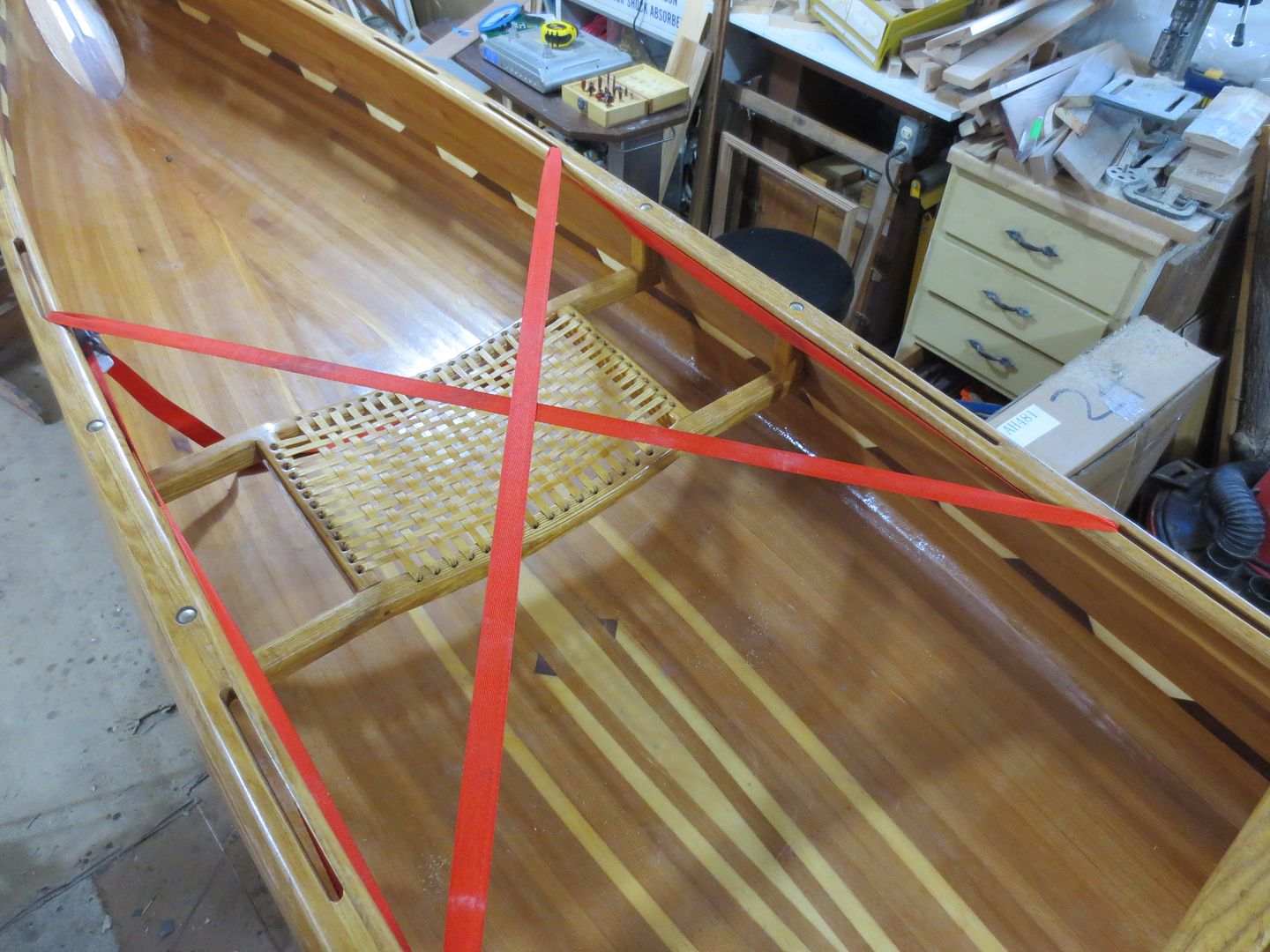
Any Ideas or comments ?
Jim
I stretched a strap to give you an idea, of what I was thinking.
The 1" nylon stretched to much, but I think the idea has some merit.
The crossed strap was pretty comfortable !!
Need to procure better strapping, with less stretch, maybe even wider !
Here's a pic.

Any Ideas or comments ?
Jim
Jim,
On some of my earlier, bigger canoes (USCA Cruisers and their variants) I used to use 2 near center thwarts. Between those thwarts I would attach 2 loops of 2" wide nylon strap. For carrying, I would slide the straps in to shoulder width, it was pretty comfortable. For paddling with gear, I would slide those straps out towards the gunnels.
I realize a pair of center thwarts might not work for a solo boat, but the concept of strapping as a portage aid is definitely practical, lightweight and comfortable.
On some of my earlier, bigger canoes (USCA Cruisers and their variants) I used to use 2 near center thwarts. Between those thwarts I would attach 2 loops of 2" wide nylon strap. For carrying, I would slide the straps in to shoulder width, it was pretty comfortable. For paddling with gear, I would slide those straps out towards the gunnels.
I realize a pair of center thwarts might not work for a solo boat, but the concept of strapping as a portage aid is definitely practical, lightweight and comfortable.
G
Guest
Guest
On some of my earlier, bigger canoes (USCA Cruisers and their variants) I used to use 2 near center thwarts. Between those thwarts I would attach 2 loops of 2" wide nylon strap. For carrying, I would slide the straps in to shoulder width, it was pretty comfortable. For paddling with gear, I would slide those straps out towards the gunnels.
I realize a pair of center thwarts might not work for a solo boat, but the concept of strapping as a portage aid is definitely practical, lightweight and comfortable.
I like that idea, running two straps along the keel line instead of between the inwales.
That could work with a solo bench seat as well, running the straps from the front edge of the seat frame to the front thwart. Using 2 inch poly webbing there should be little enough sag to make that feasible.
Might even be able to run the same set of straps forward to the bow as supplemental gear restraint when not in use as a carry “yoke”. Just flip the straps around back to the seat frame and carry away.
With some “always there” attachment point cogitation (ladder locks?) that seems an eminently practical solution. I like it!
Similar threads
- Replies
- 33
- Views
- 3K
- Replies
- 6
- Views
- 635
- Replies
- 44
- Views
- 4K
- Replies
- 19
- Views
- 747



